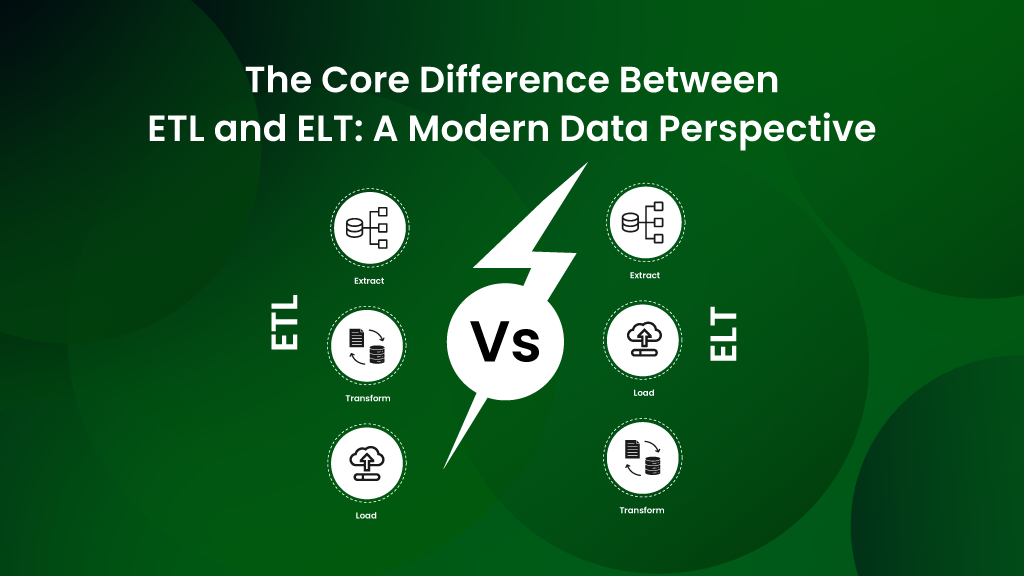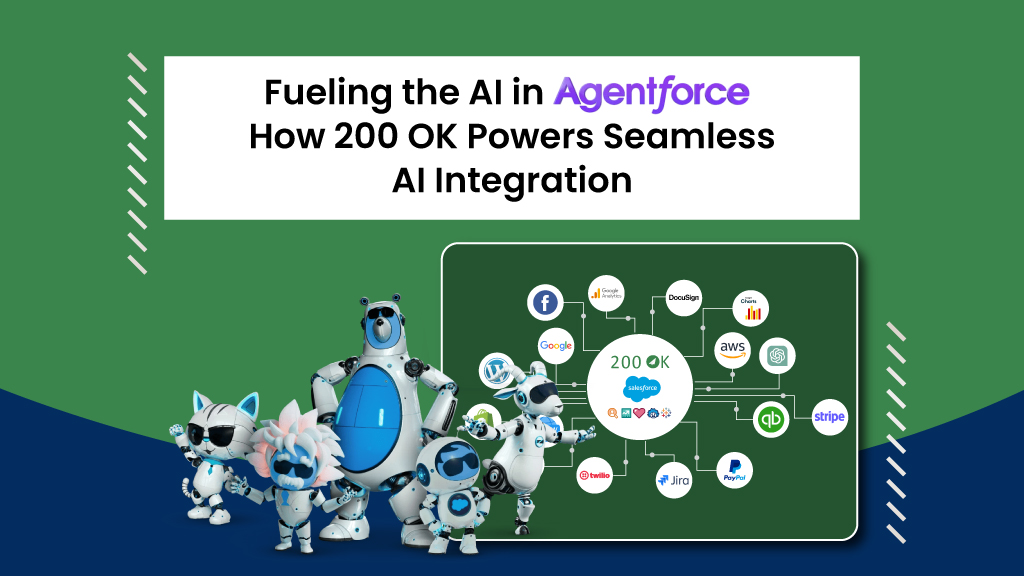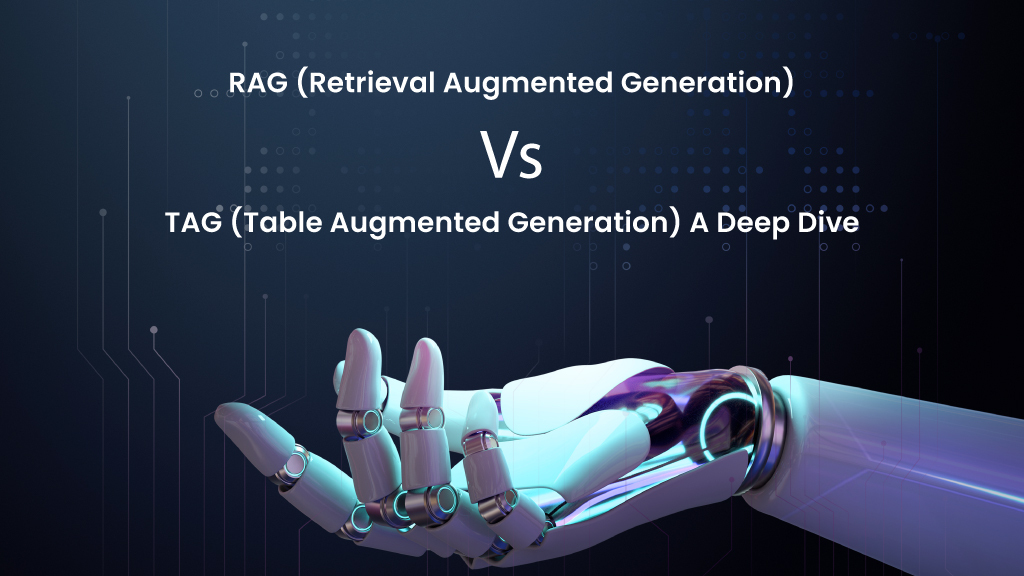Data is the backbone of each and every organization today. And this data, lying in siloes is of no use. Hence, integrating all of this siloed data is extremely important to actually do something out of that data. Various methodologies have emerged to integrate this data. A few of them are ETL, ELT, Reverse ETL, and Zero ETL. These methodologies are like the four options that you used to get the Multiple Choice Questions (in probably the third grade?).
Before any organization makes a decision of which one they must choose, it is crucial to understand what these methods are, how to use them, and how they are different from each other- The difference between ETL and ELT is the most important of all. They can’t be blindly filling out the circle of the OMR sheet like you used to do (in probably the third grade?).
In this blog, we will explore ETL and ELT, highlighting their unique characteristics, appropriate use cases and the key difference Between ETL and ELT.
ETL (Extract, Transform, Load)
What is ETL?
ETL stands for Extract, Transform, Load. ETL data transformation traditional method involves extracting data from various sources, massaging and transforming it into a suitable format required by systems, and loading it into a data warehouse or database.
Zero ETL transformation is an emerging concept where data integration happens without the traditional ETL processes. Instead, data is directly queried and analyzed from its original source. This approach aims to minimize or eliminate the traditional ETL processes by integrating data directly between systems in real-time or near real-time. It typically involves the use of data integration platforms or tools like 200 OK that allow seamless data flow and transformation on the fly without the need for intermediate staging or batch processing. Zero ETL focuses on reducing latency and complexity in data integration processes.
How does ETL work?

Extract: Data is collected from different sources such as databases, APIs, and flat files.
Transform: The extracted data is cleaned, aggregated, and transformed into a desired format or structure.
Load: The transformed data is loaded into a target system, mostly a data warehouse or database.
ETL, which is the traditional approach to data integration, ensures data quality before loading but can be time-consuming and resource-intensive.
Use Cases of ETL
Data Warehousing: ETL is commonly used to populate data warehouses, ensuring that data is clean and well-structured.
Business Intelligence (BI): ETL processes support BI tools by providing high-quality, consistent data for reporting and analysis.
Regulatory Compliance: Organizations use ETL to ensure that data is transformed and stored in compliance with regulatory requirements.
What is ELT?
How does it work?

Use Cases of ELT
- Big Data Environments:
ELT is well-suited for big data platforms like Hadoop and cloud-based data warehouses (e.g., Snowflake, Google BigQuery) that can handle large volumes of data and perform complex transformations efficiently. - Real-Time Analytics:
ELT supports real-time data processing, enabling organizations to analyze data as soon as it is loaded. - Scalability:
ELT is ideal for scalable systems that can manage the computational load of transforming large datasets.
Benefits of ETL:
- Data Consolidation: ETL enables businesses to collect the data from multiple touchpoints and store it in a central repository making it easier to analyze and generate insights.
- Data Quality and Transformation: In the ETL process, the data is cleaned before being loaded into the destined system, hence taking care of the quality of the data.
- Improved Decision-Making: When the data is cleaned before the load, and with the consolidation of the data, businesses can make the best data-driven decisions.
- Scheduled Data Integration: ETL processes can be scheduled to run at specific times, hourly, daily, monthly, or however required, allowing for routine and automated data integration from various sources, and reducing manual workload.
- Historical Data Handling: ETL can be used to extract, transform, and load historical data as well, making it easier to perform long-term trend analysis.
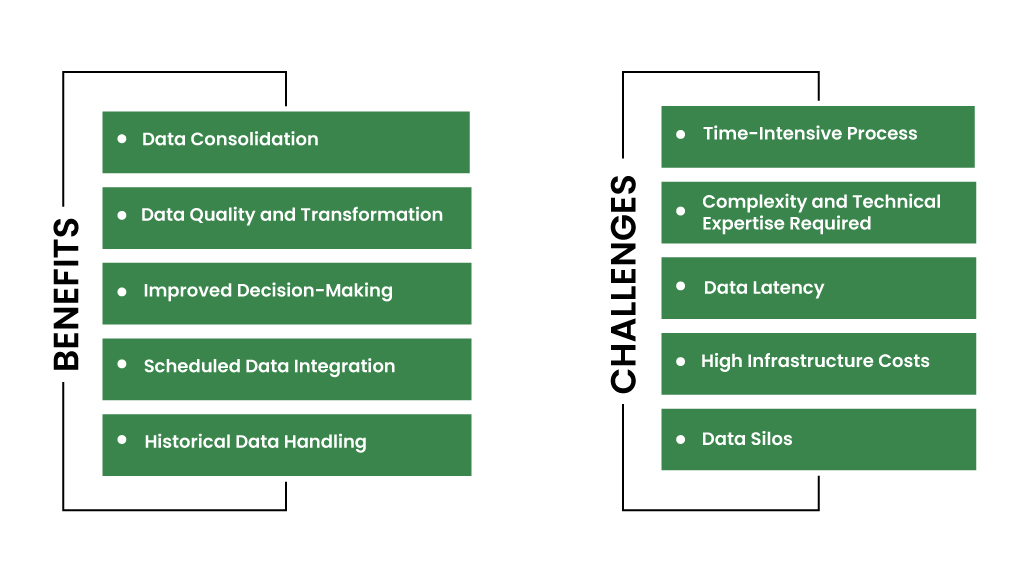
Challenges of ETL:
Time-Intensive Process:
The second stage, that is the transformation stage can be very time-consuming as the data needs to be cleaned, processed, and then loaded, making it a time-intensive process, especially with complex data sets.
Complexity and Technical Expertise Required:
ETL processes can become complex as the data grows in volume and diversity. Maintaining and scaling ETL pipelines can require significant effort and technical expertise.
Data Latency:
Since ETL transforms data before loading, there can be a delay in making the data available for real-time analytics, leading to potential latency in decision-making.
High Infrastructure Costs:
ETL can be resource-intensive, requiring significant computational power and storage for managing large datasets and performing transformations, which can increase infrastructure costs.
Data Silos:
ETL systems sometimes reinforce data silos, as they often focus on extracting data from static, siloed sources rather than leveraging real-time data streams.
Benefits of ELT:
Below are the benefits associated with ELT,
Faster Data Processing:
ELT loads raw data into the data warehouse first, allowing data to be available quickly for analysis. The transformation occurs later, leading to faster data loading times compared to ETL.
Real-Time Analytics:
Since the data is loaded before transformation, ELT supports real-time data processing, enabling businesses to perform faster, more up-to-date analytics.
Scalability:
ELT leverages the power of cloud-based data platforms to handle large data sets efficiently. As these platforms grow, ELT can easily scale to manage increasing data volumes without much complexity.
Lower Infrastructure Costs:
ELT shifts the data transformation workload to the data warehouse or cloud platform, reducing the need for expensive dedicated ETL servers. This can lead to significant cost savings, especially for large-scale data operations.
Flexibility for Data Enthusiasts:
With all raw data stored in the data warehouse, data enthusiasts can explore and experiment with the raw data, applying custom transformations and models as needed, without needing predefined transformation rules.
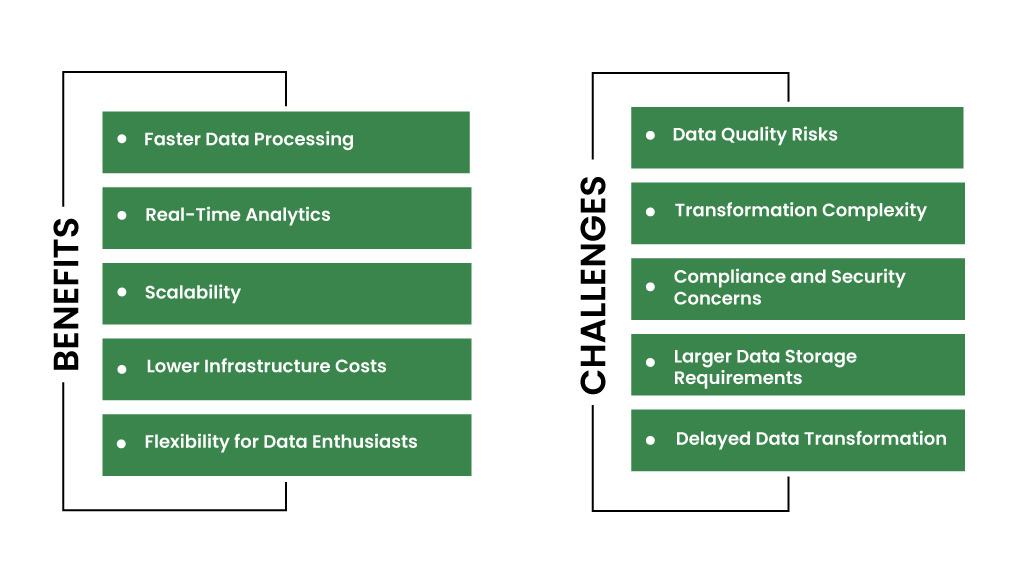
Challenges of ELT:
Data Quality Risks:
Since data is loaded without initial transformation or cleaning, there is a risk of storing low-quality or inconsistent data in the data warehouse. This can complicate data management and analysis later on.
Transformation Complexity:
Transforming data after it has been loaded requires more processing power from the data warehouse or cloud platform. This may require strong infrastructure and can slow down query performance if not managed properly.
Compliance and Security Concerns:
Loading raw data into the data warehouse can lead to compliance issues, especially when sensitive or regulated data is involved. Sensitive data may need to be transformed or masked before it can be safely stored.
Larger Data Storage Requirements:
ELT requires raw data to be stored in its entirety, which can lead to significant storage demands. For large data sets, this can increase costs, especially in cloud environments where storage consumption directly affects pricing.
Delayed Data Transformation:
While data is quickly available in its raw form, the transformation process happens after the fact, potentially delaying data insights or requiring additional steps to prepare the data for meaningful analysis.
These points provide a balanced perspective on the strengths and limitations of ELT, helping businesses weigh the method’s benefits and challenges for their data integration needs.
Comparative Analysis:
| Feature | ETL | ELT |
|---|---|---|
| Latency | Typically involves batch processing, leading to higher latency. | Can leverage real-time transformation capabilities of target systems but often involves batch loading. |
| Data Transformation | Before loading | After loading |
| Data Movement | Multiple steps | Direct loading |
| Transformation Location | Before loading data into the target system | After loading data into the target system |
| Scalability | Moderate | High |
| Real-Time Processing | Limited | Strong |
| Infrastructure Requirement | Extensive | Requires powerful target systems |
Wrap-Up: ETL vs ELT-
When ETL is Better:
Data Quality Assurance:
ETL transformation cleanses data before it enters the target system. This approach ensures only high-quality, structured data is loaded into your data warehouse, which is ideal for traditional on-premise databases.
Compliance and Security:
ETL is useful when dealing with sensitive data that needs to be processed or masked before it can be securely stored.
Controlled Processing:
ETL is often a better choice for structured, batch processing environments where the data flow is consistent and controlled.
Ideal for:
Organizations with strict data governance needs.
Smaller or mid-sized datasets where immediate access to raw data isn’t critical.
On-premise systems where transformation power comes before storage.
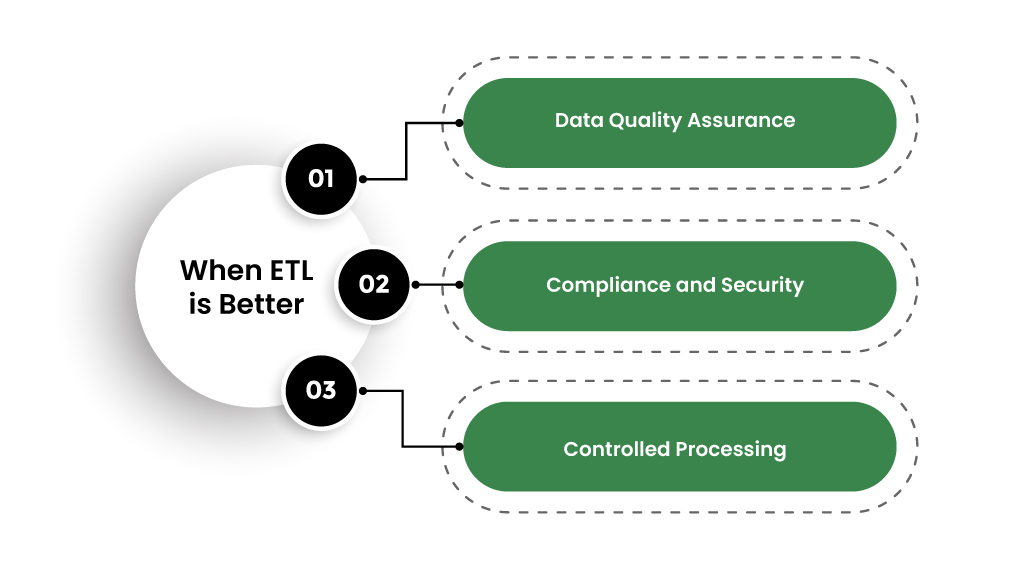
When ELT is Better:
Faster Data Loading:
ELT loads raw data into the data warehouse first, allowing for faster data ingestion and near real-time analytics. This is ideal for organizations using cloud-based data platforms (like Snowflake, Google BigQuery, or AWS Redshift).
Scalability:
ELT leverages the scalability of cloud platforms for both storage and transformation, making it well-suited for large volumes of data.
Flexible Transformation:
ELT allows data teams to store all raw data and apply transformations as needed later. This flexibility is great for data scientists who want access to the raw data for experimentation.
Ideal for:
- Organizations working with massive datasets and real-time analytics.
- Cloud-based platforms where scalability and flexibility are key.
- Businesses where raw data needs to be accessed immediately before further transformation.

Now that we’ve talked about the difference between ETL and ELT in-depth, you are fully equipped to make your decision on which method to choose.
Want a reliable partner who can provide you with your choice of integration strategy? We’re here for you! Get in touch with our product experts today.
